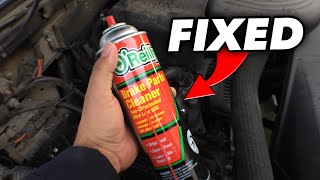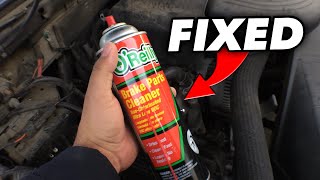Vacuum leaks are a common and frustrating problem for car owners. They can cause a variety of issues, from rough idling to decreased fuel efficiency. Fortunately, there is a simple solution to finding vacuum leaks using brake cleaner. In this article, we will explore the steps you can take to find and fix vacuum leaks in your car using this handy tool.
Brake cleaner is an affordable and effective way to pinpoint the location of a vacuum leak in your car’s engine. By following a few simple steps, you can quickly identify the source of the problem and take the necessary steps to fix it. Whether you’re a seasoned mechanic or a DIY enthusiast, this guide will provide you with the knowledge and tools you need to keep your car running smoothly. So, let’s dive in and learn how to find a vacuum leak with brake cleaner!
- Start the engine and let it idle.
- Spray brake cleaner around the vacuum lines and intake manifold.
- If the engine idle changes, there is a vacuum leak in that area.
- Repeat the process until all potential leak areas are covered.
- Once you have identified the leak, repair or replace the affected component.

How to Find a Vacuum Leak With Brake Cleaner?
Are you experiencing engine performance issues, such as rough idling, stalling or decreased power? If so, you may have a vacuum leak. A vacuum leak occurs when air enters the engine through a crack or hole in the vacuum system, causing the air-to-fuel ratio to become unbalanced. Fortunately, there’s a simple and effective way to find a vacuum leak using brake cleaner. Here’s how:
Step 1: Locate the Vacuum Lines
Before you can find a vacuum leak, you need to locate the vacuum lines. The vacuum lines are typically made of rubber or plastic and are connected to various engine components, such as the intake manifold and brake booster. Look for any cracks, holes or other damage to the vacuum lines. You may also want to use a flashlight to help you see better.
Once you’ve found the vacuum lines, it’s time to move on to the next step.
Step 2: Spray the Brake Cleaner
With the engine running, spray brake cleaner along the vacuum lines and connections. Be sure to spray the entire length of each line, as well as any connections. If there’s a vacuum leak, the brake cleaner will get sucked into the engine and cause the engine to rev higher. You’ll also hear a noticeable change in the engine’s sound.
Step 3: Identify the Vacuum Leak
If you hear a change in the engine’s sound and notice that the engine revs higher, you’ve found the vacuum leak. Check the area where the sound is coming from and look for any visible damage to the vacuum lines or connections. If you don’t see any damage, you may need to use a smoke machine to identify the leak.
Step 4: Repair the Vacuum Leak
Once you’ve found the vacuum leak, it’s time to repair it. Depending on the severity of the damage, you may need to replace the entire vacuum line or just a portion of it. You can purchase replacement vacuum lines at your local auto parts store or online. Be sure to follow the manufacturer’s instructions when installing the new vacuum line.
The Benefits of Using Brake Cleaner to Find a Vacuum Leak
Using brake cleaner to find a vacuum leak is a simple and effective method. It’s also much cheaper than taking your car to a mechanic. By finding and repairing the vacuum leak, you’ll improve your engine’s performance and fuel efficiency. You’ll also reduce the risk of more serious engine damage down the road.
Brake Cleaner vs. Other Methods
There are other methods for finding a vacuum leak, such as using a smoke machine or propane torch. While these methods can be effective, they’re also more complicated and expensive. Brake cleaner is a simple and affordable alternative that anyone can use.
Conclusion
A vacuum leak can cause a range of engine performance issues, but finding and repairing the leak is easier than you might think. By following these simple steps and using brake cleaner, you can quickly and easily identify the source of the vacuum leak and take steps to repair it. So if you’re experiencing engine performance issues, try using brake cleaner to find the vacuum leak. Your engine (and your wallet) will thank you.
Frequently Asked Questions
Here are some common questions and answers about how to find a vacuum leak with brake cleaner:
What is a vacuum leak?
A vacuum leak is a break or gap in the vacuum system of an engine. This can cause a variety of problems, including reduced power, rough idling, and even stalling. A vacuum leak can be caused by many things, including a cracked or damaged hose, a faulty gasket, or a loose fitting.
To locate a vacuum leak, you can use brake cleaner to spray the suspected area. If there is a leak, the engine will suck in the brake cleaner and cause a noticeable change in idle speed or sound.
What kind of brake cleaner should I use?
You should use a chlorinated brake cleaner, as it is more effective at detecting vacuum leaks than non-chlorinated cleaners. Chlorinated brake cleaner also evaporates more slowly, giving you more time to locate the leak before it evaporates.
It’s important to note that brake cleaner is a flammable and potentially hazardous substance, so be sure to use it in a well-ventilated area and follow all safety precautions.
Where should I spray the brake cleaner?
You should spray the brake cleaner on the suspected area of the vacuum system. This might include intake manifold gaskets, vacuum hoses, brake booster, and throttle body gaskets. You can also spray around the base of the carburetor or around the intake manifold to check for leaks.
When the brake cleaner is sprayed on a vacuum leak, the engine will suck it in and cause a noticeable change in idle speed, pitch, or sound. This will help you locate the source of the leak.
Can I use any other method to locate a vacuum leak?
Yes, there are other methods you can use to locate a vacuum leak. Some people prefer to use a smoke machine, which pumps smoke into the intake system and helps locate leaks. You can also use a propane torch or carburetor cleaner to locate leaks.
However, brake cleaner is a simple and effective method that is widely used by mechanics and DIY enthusiasts alike.
What should I do if I find a vacuum leak?
If you find a vacuum leak, you should replace the damaged component or repair the leak as soon as possible. A vacuum leak can cause a variety of problems, including reduced power, rough idling, and even stalling. It can also lead to more serious engine damage if left untreated.
It’s important to note that some vacuum leaks can be difficult to locate, so don’t hesitate to seek professional help if you’re unsure about how to proceed.
How to [CHEAP] Find Vacuum Leaks with Brake Cleaner
In conclusion, finding a vacuum leak with brake cleaner is a simple and effective method that can save you time and money. By following the steps outlined in this guide, you can quickly locate the source of the leak and make the necessary repairs to your vehicle’s vacuum system.
Remember to always take safety precautions when working with brake cleaner, such as wearing gloves and working in a well-ventilated area. Additionally, be sure to use a high-quality brake cleaner that is safe for use on your specific vehicle.
Don’t let a vacuum leak go undetected – it can lead to decreased performance and even damage to your engine over time. With this easy-to-follow method, you can identify and fix the problem quickly and get back on the road with confidence. So, go ahead and give it a try – your car will thank you for it!

